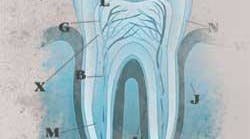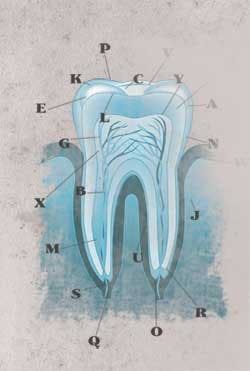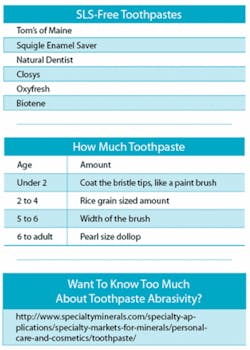Toothpastes and Other Mysteries
In the realm of minimal intervention in dental hygiene, the matter of toothpaste cannot be overlooked. Nearly everyone uses it, and some toothpastes have become high tech.
Throughout the 1980s, toothpastes were a vehicle for delivering fluoride in a safe and effective manner. There was little to it — squirt some on the brush, smoosh it around the teeth, and the teeth come out clean and slick. The most important thing to look for was the abrasiveness of the paste, even though there was no real scale used to measure abrasiveness.
In general, all toothpastes have a humectant, abrasive, sweetener, and a couple of other ingredients that put it in the toothpaste category. Recently, toothpastes have adopted other ingredients that hoist good enamel health and good periodontal health onto unsuspecting people. By adding and subtracting attributes to the paste, better oral health is created because of changes to the oral environment.
How to Use Toothpaste
Using toothpaste isn't discussed much, but there is a specific way to use toothpaste in general. In order to maintain the low-dose long-duration fluoride in the mouth that is so beneficial, the CDC recommends that people use a small amount of paste, brush for two minutes, and not rinse after expectorating the excess.
The Attributes
Last month, this series looked at ACP as an adjunct to the products used in the dental treatment room. It's also available in toothpaste. Arm & Hammer calls it liquid calcium, and it claims to make teeth smoother. It doesn't state for how long, but assuming a person uses the paste twice a day and if the saliva is healthy, the teeth will absorb the ingredient and changes toward health will occur.
When and Who: An ACP toothpaste is for people who have dry mouth issues. This is if they can handle the spicy flavor twice a day, or at least before bed.
Xylitol is another ingredient that has been added to create changes toward health. Xylitol inhibits streptococcus metabolism. The bacteria starve in the presence of xylitol, effectively killing the pathogens in an untraditional way. Xylitol toothpastes are easily available over the counter. Although many toothpastes contain xylitol, the more used the better for attaining the change needed, and xylitol toothpaste will be a small portion of a xylitol regimen. Using xylitol toothpaste without other applications will not create the desired change.
When and Who: Xylitol toothpaste should be used twice a day for people with an overwhelming bacterial infection. This includes people with minimal saliva, as the same number of pathogens in a mouth with healthy salivary flow can be detrimental to those with low salivary flow. Using a power brush will keep xylitol in the mouth longer.
Desensitizing toothpastes have been around for awhile. There are many on the market, and each has a different way of attacking problems. Potassium nitrate works well in certain circumstances. This chemical works on the polarization mechanism of the nerve endings in the dentinal tubules. The chemical works on the polarization mechanism of the nerve endings in the dentinal tubules. The label may advise not using the toothpaste for longer than a couple of weeks, stopping some patients from using the toothpaste for months in an attempt to avoid a dental visit. Not all sensitivity is caused by root exposure, as we well know.
Other ingredients in toothpaste for desensitizing are fluoride and strontium chloride, and both block the tubules. If one doesn’t work, another may.
Among the professionally dispensed toothpastes, the ones with a high concentration of fluorides are very popular. Denclude operates on a different principle; it physically blocks the dentinal tubules and fills them in for faster and longer lasting relief. Denclude contains all the components of toothpaste, including a humectant and an abrasive. MI Paste uses the same principle for sensitivity relief but doesn't have the abrasive, and may not work as well as a toothpaste.
When and Who: If your patients try the desensitizing toothpastes, find out if they use them as directed and brush twice a day. If not, it may be worthwhile for them to try the proper application methods. If they have and are still experiencing sensitivity, it may be alleviated with professionally dispensed tubule packing/blocking pastes.
Triclosan is a toothpaste ingredient that helps kill bacteria. The beauty is that it keeps germs at bay for longer than it takes to brush properly. In an effort to decrease bacteria and the full body effects of inflammation, a long-term bacteriacide may be helpful. Reports about triclosan run hot and cold. Some alarmist groups claim dire consequences from the use of triclosan. Using it has not proven harmful in most cases, but if fear prevails, it may be worthwhile to view triclosan as a medication with a short-term duration.
Tartar control toothpastes have been around for awhile and can decrease calculus buildup. It's best to use a small amount of tartar control toothpaste, and to start on the lower anterior teeth where the calculus is usually the most built up. In terms of minimal intervention, tartar control toothpastes are very helpful. The point of MI is the least intervention with the biggest impact. However, you may want to see a patient with an abundance of calculus every three months. This gives your hand a break, and it's better for the patient and his or her wallet to use a paste that can chemically alter the surface of the enamel to discourage calculus formation.
Sodium laurel sulfate (SLS) is a common ingredient in toothpastes that can irritate some people. It should be one of the first things eliminated for people with an unknown reaction of the oral mucosa, as well as for people undergoing treatments that can affect the mucosa. SLS is a foaming agent that can even cause taste alterations.
Avoid SLS toothpaste for patients with Sjögren's, Crohn's, or apthous ulcers. As a topic, the pH of toothpastes is also surfacing in discussions on the Amyrdh.com list. The reasons for having acidic toothpastes is two-fold. The lower pH creates a situation where the enamel breaks apart on a chemical level. This liberates the calcium and phosphate to bond with the fluoride in the paste as the pH normalizes, thus creating fluorohydroxyapatite (acid resistant) enamel. The higher pH toothpastes can create calculus.
Ask tough questions about the toothpastes you recommend, and keep a file of new pastes and their ingredients to help bring oral health to your patients.
About the Author
Shirley Gutkowski, RDH, BSDH, FACE, is co-director of CareerFusion and a practicing dental hygienist. She is co-author of the bestselling book, The Purple Guide: Developing Your Clinical Dental Hygiene Career with Amy Nieves, RDH. She can be contacted at [email protected].








